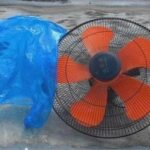The heating plate is critical to the longevity of your rice cooker, the quality of the cooked rice, and energy consumption. However, it tends to get dirty quickly due to food residue and is often overlooked during cleaning.
If your rice cooker has been taking longer to cook rice, consuming more energy, or producing burnt or poorly cooked rice, it’s time to inspect and thoroughly clean the heating plate. This component requires regular maintenance as it is prone to accumulating dirt and grime.
To ensure the durability of your rice cooker and efficient energy usage, follow these steps to clean the heating plate:
Step 1:
Prepare a small amount of white vinegar, a sponge scrubber, and a damp cloth. Dilute the vinegar with water.
Step 2:
Using the rough side of the sponge scrubber, thoroughly clean the heating plate to remove any dirt and grime. Once cleaned, apply vinegar to the plate again and let it sit for 10-15 minutes.

Step 3:
Use the damp cloth to wipe the heating plate clean. If there is still dirt or residue, repeat the previous steps as needed.
Step 4:
Finally, use a dry cloth to wipe the heating plate one last time to ensure it is completely dry. Your heating plate should now be clean, shiny, and ready for use, contributing to the efficiency and longevity of your rice cooker.
Additionally, it is important to know how to clean the other parts of your rice cooker to maintain its performance, energy efficiency, and longevity.
How to Clean Your Rice Cooker
Step 1: To clean the inner pot, remove any leftover rice using the provided spoon.

Use the spoon that comes with the rice cooker to remove leftover rice.
Step 2: Use a clean cloth to wipe down the inner pot.

Wipe down the inner pot with a clean cloth to remove any remaining rice.
Step 3: Use a soft cloth or sponge to gently clean the inside of the pot under running water. Avoid using excessive force to prevent damage.

Gently clean the inside of the pot with a soft sponge.
Note: If there is still a lingering smell after cleaning, soak the pot in boiling water for 30 minutes, then wipe it clean with a dry cloth and let it air dry.
Step 4: To clean the body of the rice cooker, use fine sandpaper to gently scrub away any rice grains or similar debris from the heating plate (thermal sensor). Afterward, wipe it clean with a dry cloth.

Use a dry cloth to wipe the inside of the rice cooker body clean.
Step 5: Gently wipe down the body and lid of the rice cooker with a dry cloth.

Gently wipe down the body of the rice cooker with a dry cloth.

Clean the lid of any remaining water droplets and rice residue.
Note: Do not submerge the body of the rice cooker in water or pour water directly onto it, as this may cause electrical issues and damage the appliance.
Step 6: Once you’ve thoroughly dried the rice cooker with a clean cloth, it’s ready to be used for cooking food again.

After cleaning the rice cooker, you can start using it to cook rice again.
Important Notes on Rice Cooker Maintenance
1. Regularly Clean the Exterior of Your Rice Cooker
It’s important to clean the exterior of your rice cooker regularly, as many people overlook this aspect. During cooking, steam and rice residue can accumulate on the lid and, if not cleaned periodically, can build up and burn, causing an unpleasant smell. Use a damp cloth to wipe down the exterior, but avoid pouring water directly onto the body of the rice cooker.
2. Do Not Disassemble the Rice Cooker
When cleaning your rice cooker, it’s important to clean both the interior and exterior. However, you should only unplug the power cord and remove the inner pot, water collector, and anti-overflow tray. Do not disassemble any other parts, as this may expose electrical components to water, leading to potential electrical hazards.
Additionally, reassembling the rice cooker can be challenging, and improper reassembly may disrupt the appliance’s functionality. Therefore, it’s best to avoid disassembling the rice cooker unless absolutely necessary.
3. Soak the Inner Pot in Cold Water Before Cleaning
Rice is sticky, and some grains may remain in the pot after a meal. Instead of scrubbing the pot right away, soak it in cold water for about 5 minutes, then use a soft sponge and a mild detergent to clean it.
4. Ensure the Rice Cooker is Dry After Cleaning
After cleaning the inner pot and exterior of the rice cooker, use a soft cloth to thoroughly dry all components, especially the areas where the power cord connects to the pot. This helps prevent rust and reduces the risk of electrical hazards.
Giadinh.net
The Ultimate Guide to Pre-Lunar New Year Cleaning: Mastering the Art of TV and Fridge Maintenance for a Sparkling Celebration
“Keeping your home clean and tidy isn’t just about sprucing up living spaces; it’s also about maintaining the hygiene of your household appliances. A clean home is one where every corner, every device, and every detail is given attention and care, creating a wholesome and healthy environment for you and your family.”






































